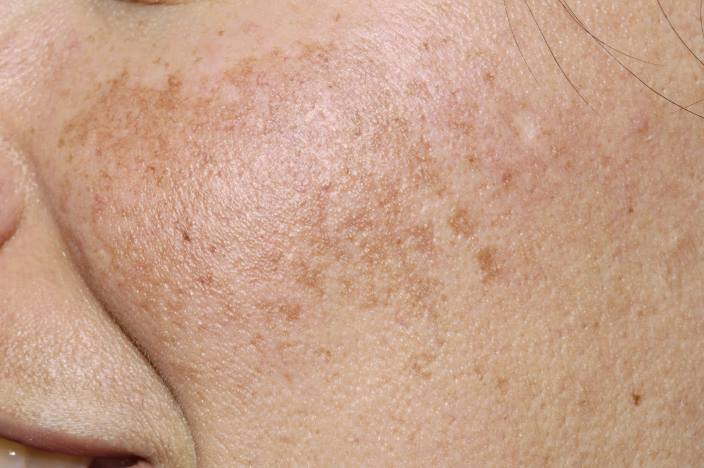Melasma is a common skin disorder that happens overproduction of melanin and is not harmful. Melasma is characterized by gray-brown discolored patches of the skin occurring in areas exposed to the sun. Read this post till the end to know the causes, prevention, and safe ways to reduce melasma naturally at home.
Causes Of Melasma:
- Sun exposure
- Pregnancy
- Certain medications
- Thyroid
- Stress
- Genetics
- Certain skin-care products
Natural Tips To Reduce Melasma
- Aloe vera gel
- Tomato paste
- Licorice extract
- Red lentil powder
- Potato Juice
How To Use Aloe vera Gel To Treat Melasma
- Cut off one leaf from a fresh aloe vera plant.
- Wash it off.
- Peel it properly.
- Scoop out its gel.
- Blend to apply it easily.
How To Apply Aloe vera Gel To Treat Melasma
- Take a bowl.
- Add 2 tablespoons of aloe vera gel.
- Add 1 pinch of turmeric and ½ tablespoon of lemon juice.
- Mix well all the ingredients.
- Apply to your affected areas.
- Leave it for 25 minutes.
- Wash it off.
- Moisturize your skin with a moisturizer according to your skin type.
How Often To Use
You can use it daily.
If your skin is sensitive, avoid using lemon juice daily. Aloe vera gel and turmeric are the best combinations.
How To Use Tomato To Treat Melasma
- Take one tomato.
- Wash it.
- Squeeze to extract the juice or blend it.
- Strain the juice after blending.
- You can store tomato juice in a fridge for 1 week and freezer for 3-4 weeks.
How To Apply Tomato To Treat Melasma
- Take a bowl.
- Add gram flour 2 tablespoons and add enough tomato juice to make a paste.
- Apply on your face.
- Leave it for 25 minutes.
- Wash it off.
- Moisturize your skin with a moisturizer according to your skin type.
How Often To Use
You can use it daily and leave it for 5 minutes.
If your skin is sensitive, avoid using lemon juice daily. Aloe vera gel and turmeric are the best combinations.
How To Use Licorice To Treat Melasma
- Make a fine powder of licorice.
- You can store licorice powder in a container for a long time.
How To Apply Licorice To Treat Melasma
- Take a bowl.
- Add 2 tablespoons of licorice powder and add enough yogurt to make a paste.
- Add ½ tablespoon lemon juice.
- Mix well.
- Apply on your face.
- Leave it for 25 minutes.
- Wash it off.
- Moisturize your skin with a moisturizer according to your skin type.
How Often To Use
Use it thrice a week.
How To Use Red Lentil To Treat Melasma
- You can make a powder of red lentil powder and wash your face daily.
- Use soaked red lentils to make a face pack.
How To Apply Red Lentil To Treat Melasma
- Take a bowl.
- Add 2 tablespoons of red lentil powder and wash.
- Soak in water overnight.
- Blend the mixture the next morning (after 8-10 hours)
- Apply on your face.
- Leave it for 25 minutes.
- Wash it off.
- Moisturize your skin with a moisturizer according to your skin type.
How Often To Use
Use red lentil paste thrice a week.
How To Use Potato To Treat Melasma
- Take one potato.
- Peel it.
- Grate to extract the juice.
How To Apply Potato To Treat Melasma
- Take a bowl.
- Add gram flour/chickpea flour 2 tablespoons and 1 pinch of turmeric.
- Add enough potato juice to make a paste.
- Apply on your face.
- Leave it for 25 minutes.
- Wash it off.
- Moisturize your skin with a moisturizer according to your skin type.
How Often To Use
Use a potato face pack thrice a week.
If your skin is sensitive, avoid using lemon juice daily
Prevention For Melasma:
- Use sunscreen daily.
- Re-apply sunscreen in peak hours.
- Avoid tanning beds
- Avoid using irritating skin-care products
- Follow gentle skin care.
- Use products according to your skin type.
Medical Treatment For Melasma
Hydroquinone is often prescribed by doctors as the first line of treatment for melasma. It’s available in prescription strength as a lotion, gel, cream, or liquid.
Other treatments may include:
- Tretinoin
- Corticosteroids
- Triple cream (combination of hydroquinone, tretinoin, and a corticosteroid)
- Azelaic acid
- Kojic acid
If topical treatment isn’t working, your dermatologist might recommend a procedure that are mentioned below:
- Chemical peel
- Dermabrasion
- Microdermabrasion
- Laser treatment
- Light-based procedure
- Micro-needling
Make sure to consult a dermatologist before using any topical treatments.




